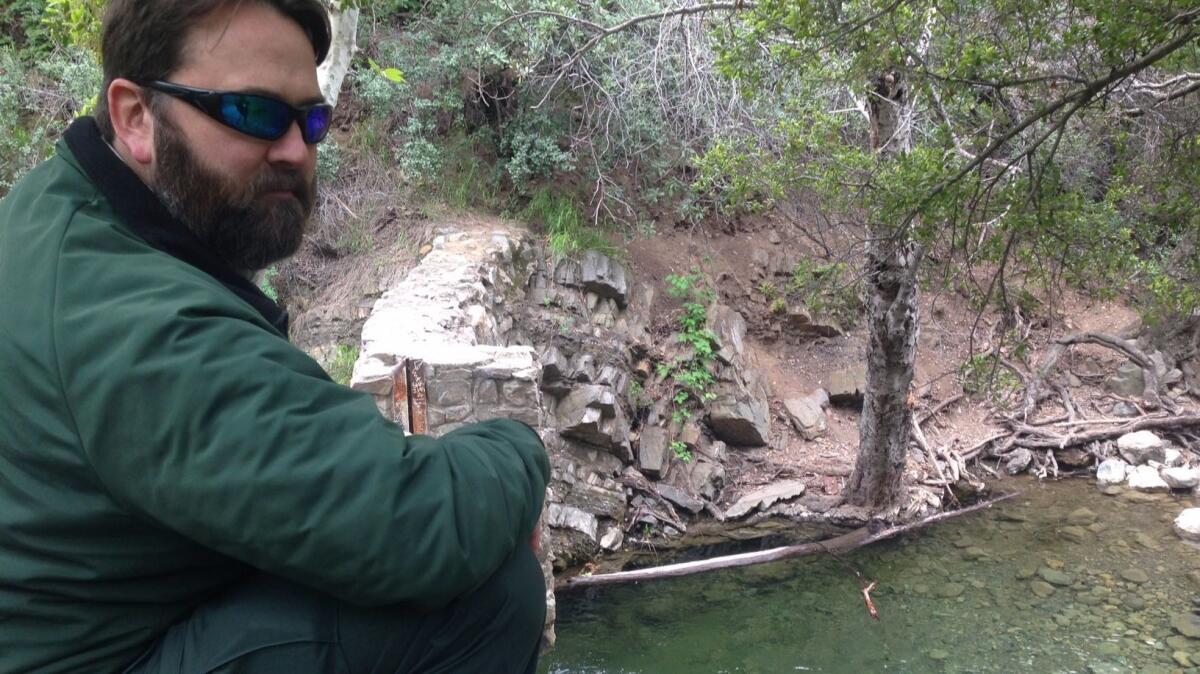Canyon dwellers confront deputies, Marines and Forest Service on plan to blow up dams that formed cherished swimming holes

- Share via
In a daybreak showdown Tuesday, more than a dozen Silverado Canyon residents and environmentalists gathered at a blockade of about 20 Orange County sheriff’s deputies, some with police dogs.
They had come to the end of the winding mountain road to protest federal authorities’ plans to blow up five vintage stone-and-mortar dams.
For the record:
12:27 a.m. Feb. 22, 2025An earlier version of this article misidentified Silverado Canyon as Santiago Canyon and Silverado Creek as Santiago Creek.
At the root of the dispute are opposing views of residents’ rights to preserve a culture they say is as worthy of protection as the land they live on and the wildlife it supports.
Officials say the demolition conducted by the U.S. Forest Service and U.S. Marine Corps aims to restore wildlife habitat and eliminate safety hazards along Silverado Creek in Orange County’s Santa Ana Mountains.
Opponents worry it will clog Silverado Creek with debris, kill aquatic wildlife and wipe out popular swimming holes beneath two of the dams.
The very idea of Marines coming in with explosives caused a lot of alarm around here.
— Joel Robinson, Silverado Canyon resident and protest organizer
“The very idea of Marines coming in with explosives caused a lot of alarm around here,” said protest organizer Joel Robinson, a Silverado Canyon resident of seven years.
“And while we’re usually all for restoring streams to their full potential by tearing down dams, we don’t believe that spring is the best time for such a thing,” he said. “Beyond that, there are luxurious swimming holes up there that we don’t want to lose.”
Linda May, a spokeswoman for the nonprofit Intercanyon League, agreed.
“This issue is mostly about our way of life,” she said. “We want that stream to be as natural as possible. It’s just a few idyllic spots we’re concerned about.”
By 10 a.m. the Forest Service announced a compromise.
“Our goal is ecological restoration,” said Darrell Vance, Trabuco District ranger for the agency. “But it sounds like those swimming holes are more important to folks around here than the dams themselves. So, we’re going to demolish three dams today, and leave the two with swimming holes where they are.
“Eventually, those dams will have to come down, too,” he added. “In the meantime, we’re going to try and figure out a way to keep those swimming holes intact after the dams are gone.”
As he spoke, federal biologists upstream were using nets to capture California newts and chorus frogs so that they could be relocated.
That compromise was not enough to satisfy critics who were outraged that the U.S. Fish and Wildlife Service had determined that removing the dams would not have a significant impact on canyon lands designated as critical habitat for federally endangered arroyo toads.
The warty, buff-colored amphibians were documented in the lower end of the creek as recently as 2005.
“This is a tragic event for the toads,” said Ed Amador, president of the nonprofit Canyon Land Conservation Fund. “Federal officials didn’t have to do this in critical arroyo toad habitat during the animal’s breeding season.”
Of particular concern is the fate of a deep and clear swimming hole beneath one of the dams. Guarded by steep granite cliffs and dense stands of poison oak, the summer hot spot is about a mile upstream from the homes of many opponents of the demolition project.
On Tuesday, the only signs of human activity were a wooden Adirondack chair and a folding table.
More to Read
Sign up for Essential California
The most important California stories and recommendations in your inbox every morning.
You may occasionally receive promotional content from the Los Angeles Times.











